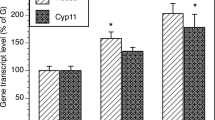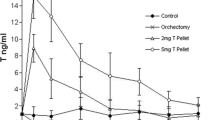Abstract
Experiments have been designed to investigate hormonal effects on the human prostatic carcinoma cell line LNCaP in the presence of complete foetal calf serum. At physiological concentrations (3.3 x 10(-9)M), several derivatives of 17 alpha-methyl-testosterone led to a significant reduction of cell proliferation, inhibition of colony formation in soft agar, change of morphology, induction of a prostate specific mRNA and down-regulation of c-myc RNA. Two different antiandrogens, hydroxyflutamide and cyproterone acetate, were capable of reversing the effects exerted by the synthetic androgens on growth properties. The proliferation rate of control cells devoid of androgen receptor was not inhibited by synthetic androgens. Our results indicate that the cellular androgen response mechanism of LNCaP cells is intact and that synthetic androgens elicit androgen receptor mediated suppression of the transformed phenotype. Rare cases of remission of prostatic cancer on androgen treatment have been reported. LNCaP cells may be a model of an uncommon class of prostatic cancer which responds favourably to androgen treatment.
Similar content being viewed by others
Author information
Authors and Affiliations
Rights and permissions
About this article
Cite this article
Wolf, D., Schulz, P. & Fittler, F. Synthetic androgens suppress the transformed phenotype in the human prostate carcinoma cell line LNCaP. Br J Cancer 64, 47–53 (1991). https://doi.org/10.1038/bjc.1991.237
Issue Date:
DOI: https://doi.org/10.1038/bjc.1991.237
- Springer Nature Limited
This article is cited by
-
Antiproliferative activity of casodex (ICI 176.334) in hormone-dependent tumours
Journal of Cancer Research and Clinical Oncology (1993)




